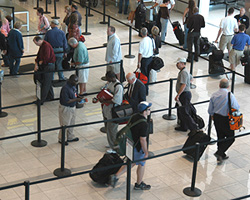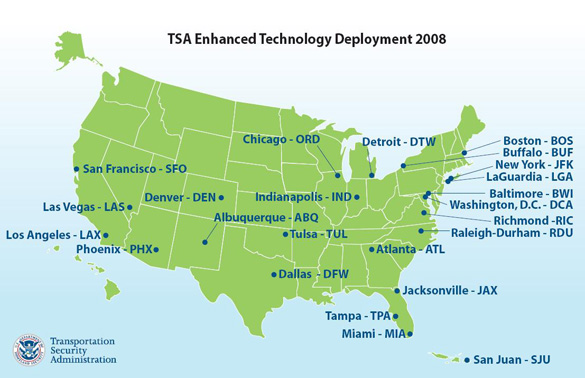Whole Body Imaging
Innovation & Technology
Paperless Boarding Pass | Threat Image Projection | Trace Portals
Whole Body Imaging
(The Buffalo News)
Click here to read 'Screeners get closer look'.
(Tulsa World)

Passenger imaging is an umbrella term used to describe technologies that visually screen travelers, allowing TSA to more thoroughly detect weapons, explosives and other threat items.
TSA is using two different types of passenger imaging technology: backscatter and millimeter wave.
TSA began piloting backscatter passenger imaging technology at Phoenix Sky Harbor International Airport (PHX) in February 2007. Testing of millimeter wave technology began at PHX in October 2007.
Millimeter wave is used in random continuous screening protocol except at PHX were it is used in secondary screening. At PHX, JFK and LAX, backscatter technology is used in secondary screening. More than 90 percent of passengers in Phoenix opted for millimeter wave over the traditional pat-down procedure during the pilot.

Millimeter wave will be deployed to airports nationwide during 2008 to include: Baltimore-Washington, Los Angeles, Phoenix, Albuquerque, Denver, Dallas/Fort-Worth, Detroit, Miami, Ronald Reagan Washington National, New York John F. Kennedy, Las Vegas, Atlanta, Boston, Indianapolis, New York LaGuardia, Tampa, San Juan, San Francisco, Buffalo, Chicago O'Hare, Richmond, Tulsa, Jacksonville and Raleigh-Durham.
TSA also plans to purchase and deploy an additional 80 passenger imagers, bringing the total to 120 Passenger Imaging units nationwide in 2009.
What are the Privacy Measures of Passenger Imaging?
Images will not be printed, stored or transmitted
To ensure privacy, the passenger imaging technology being tested by TSA has zero storage capability and images will not be printed stored or transmitted. Once the transportation security officer has viewed the image and resolved anomalies, the image is erased from the screen permanently. The officer is unable to print, export, store or transmit the image.
Screener viewing images is remotely located
In addition to not storing, printing or transmitting the image, the transportation security officer will be viewing the image on a stand-alone machine (vs. network) that is located in a remote area from the screening process. The image will not be visible to the public, and the viewing transportation security officer will not be permitted to bring any camera into the viewing area. The transportation security officer attending to the passenger at the machine is unable to see the image being produced. The officers communicate wirelessly during the screening process.
Click here to learn more about Backscatter technology.

